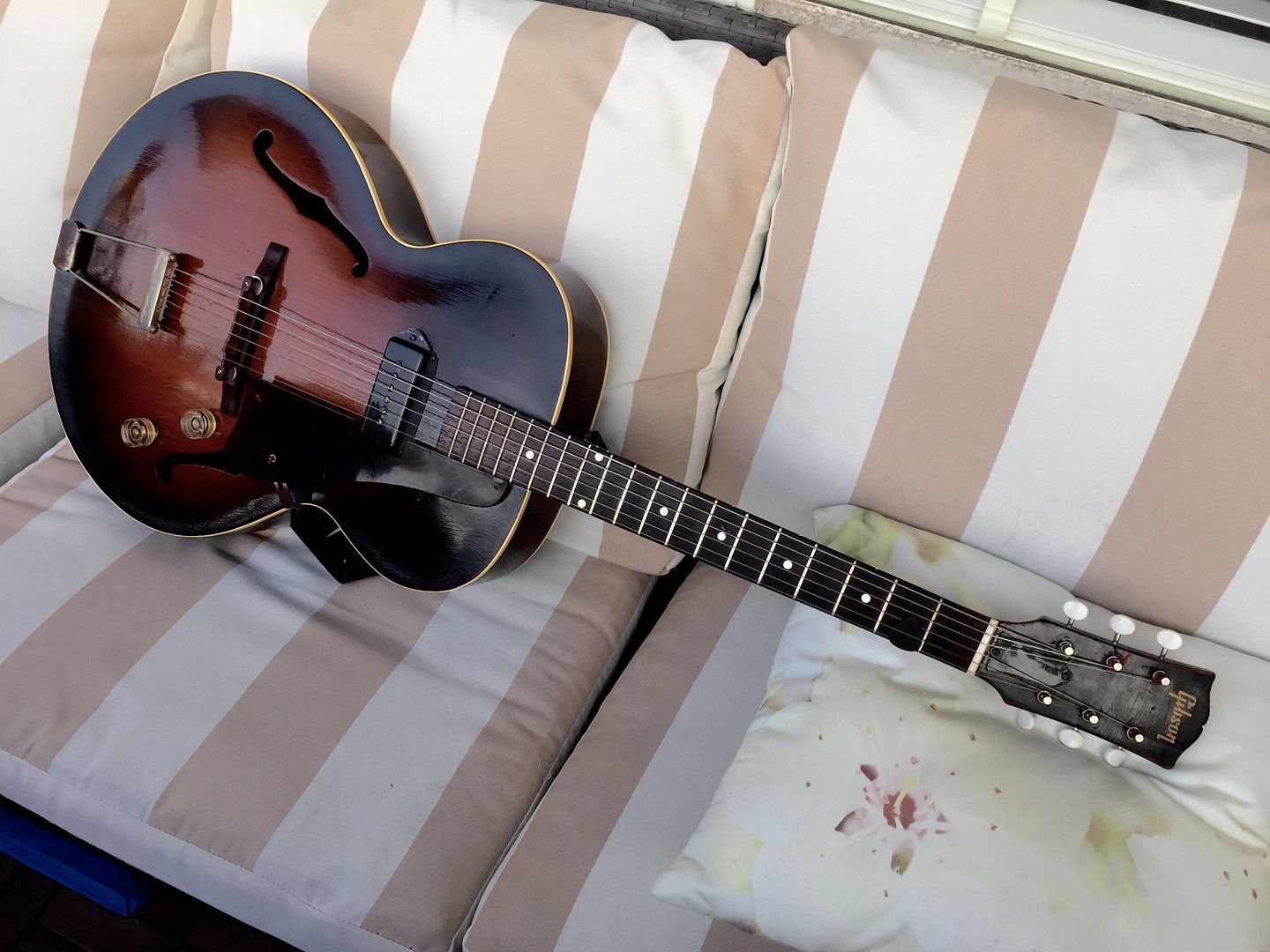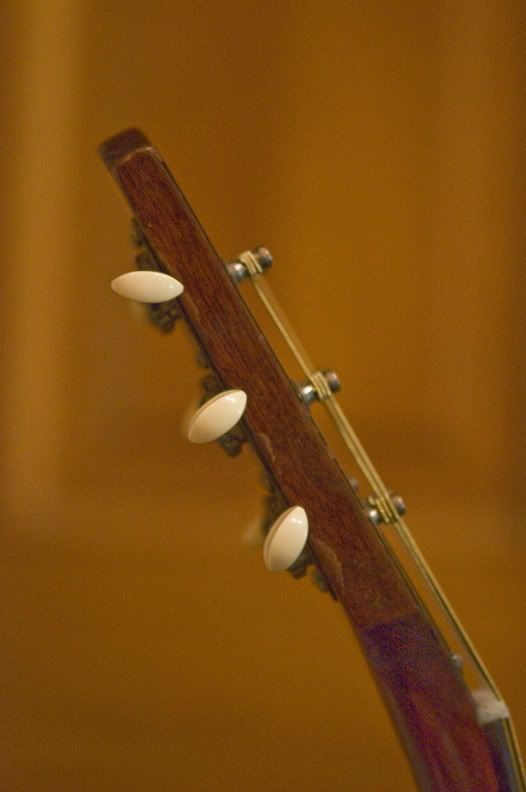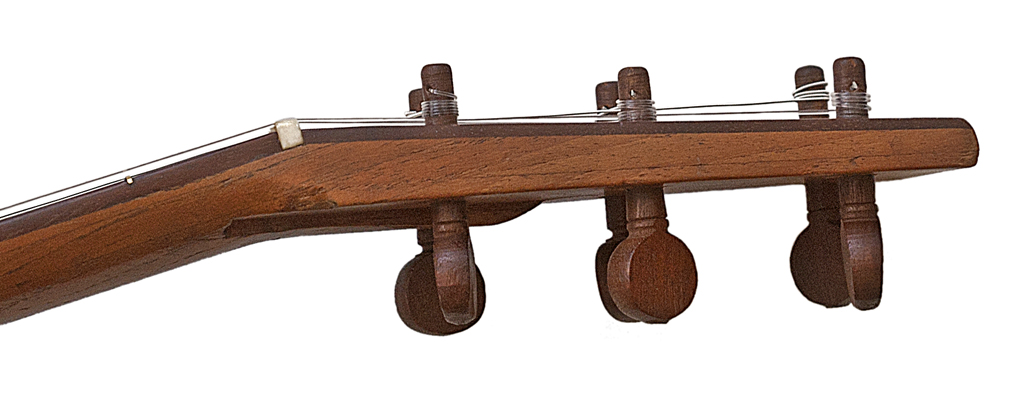
-
Last week I bought a 1955 Gibson LG-3 acoustic flat top, in playable condition, worn but not abused. I was approached by someone , who knew i was a jazz player offering to do a swop for a 1956 Gibson L-48 also in playable condition.
So what opinions are there out there? is the L-48 a player, as i don't collect but want to use my guitars at gigs
I did research the vintage pricing and my local gibson store looked them up in some book and said an excellent Lg3 was listed at $3000 (us dollars) BUT the same condition 1956 L-48 was only listed at $1800 so a big price difference.
Which makes me think...
Although i would prefer a jazz guitar (archtop) to a flat top, as i play flamenco nylon and archtops but seldom steel flattop. So just a bit concerned i have found a gem here and trading it for a lesser gem (as i do love that old L48 look).
Any input greatly appreciated...

-
-
the LG-3 is worth about $1500 in exc condition, the L-48 about $900
-
The Vintage Guitar Price Guide from 2009 reads:
Gibson L48, Model Year 1950-1959, exc. cond., price range from 1.300 to 1.450 USD
Gibson LG-3, Model Year 1952-1955, exc. cond., price range from 2.500 to 2.800 USD
-
that guide is never right,
check ebay completed listings for realistic selling prices
-
thanks for the input but maybe i should rephrase my general question as i'm not too concerned about the actual price but rather thats beside the point ...........the new question is
"what is the Gibson L48 (1956 model) like as a jazz guitar ...............?????"
any issues???
and then as a secondary question do you think it's worth a trade for a Gibson Lg3 ..... and no matter what the value is (true value in dollars ) it seems the Lg3 is about 30 - 40% more higher valued than the L48 ....... as the estimate i got from a vintage guitar dealer , the one wintermoon posted and the one gergit posted ...may differ in dollar value BUT the Lg 3 is consistantly valued at a higher price......
so the question is ... is having an L48 for jazz a good move or not ............ ( i have a 1960 hofner 457 archtop at the moment as my main archtop .... is the L48 way better (i would think so ... but i need some advice here ) as the deal would be a swop .... so for sure i will lose money in value but i have more use for a jazz guitar ...and for me a Gibson archtop from 50's does not cross my threshold every day .........
believe me i'm thinking long and hard
Last edited by Keira Witherkay; 01-30-2013 at 04:47 PM.
-
With an L48 - or an L50 for that matter - you get a player and not a collectors item. So it should be playable - in good playing condition and reasonably priced.
The question is - given what we have come to know about you and your playing style so far - if you are not better off with an ES 125 or ES 150. If they are in good condition, they can be great players guitars (more than collectors items). When I was young, I was in London and came across a 1950s ES 125 - P90 pickup - with the finish stripped off. It was certainly not stunning to look at, but it sounded so good though an amp, it played fine and I had a feeling it was a guitar I could really bond with. Sadly, though it wasn't expensive in those days, I didn't have the money. If I have had, I think it would have been a guitar which would have been with me as a workhorse to this day - much like Barney Kessel and his ES 350.
-
L-48 are a lower model in the Gibson line. they're ok, but I'd almost like to see you w/ an L-7 if you want a Gibson acoustic archtop. it's an inch wider and you'll get a fuller sound.
but if you'll be playing electric the 125 or 150 as oldane suggested are a good choice
-
Not to be blasphemous, or anything, but all an L48 is is old and cool looking. They're nothing special to play or hear.
Now, if you can find one in good shape a good deal cheaper than a 125 or 150 and you got a pickup to put on it, well...
-
L-48 - cool cheap laminated player, but no one cares.
LG-3 - cool used-to-be-cheap player. A few people care, even though many of these guitars are crap, IMO, and I've played lots of them. Some of them are fantastic.
Tha market values the little flattop more - simple demand curve.
So if you like the L-48 get a few hundred bucks thrown in on the deal IMO.
All good for gigging and having mojo and so forth, with low financial loss if you need to use the guitar as a weapon.
---
Regarding the comparison to the 1960 Hofner 457:
The Hofner has an @25 1/4" scale, the L-48 has an @24 3/4" scale. Your guitar is actually a Model 457/S/E1 (it has a cutaway amd one pickup) from the pix you posted before.
The Hofner has a maple/walnut/beech laminated neck and the L-48 has a mahogany neck.
Both are all-laminated but the Hofner laminations are lighter, and the Hofner has better acoustic volume.
Slim possibility that the top of your 457 is solid spruce as opposed to laminated spruce but I'd need to see super-close-up pix to provide an opinion (I evaluate these guitars all the time for people).
Unless the longer scale is a problem for you, there is no reason to get the L-48 given that you have the Hofner. Both guitars do the same thing.
Build quality is excellent on both instruments but your 457 is a way nicer guitar than any L-48 I've ever played.
The 457 was in the middle of the Hofner 16" archtop range, fancier than the 449, 450, 455 and 456 models. There were other fancier 16" archops (458/459/461/462/463/464/465) but they were all functionally the same, just variations on the 457 with aesthetically distinctive features.
The L-48 was at the bottom of the post-war Gibson 16" acoustic archtop range, below the L-50 and the L-4.
Last edited by Hammertone; 01-11-2018 at 01:16 PM.
-
A friend of mine does jazz gigs regularly with an L48/DeArmond and sounds great.
I believe L50s had a carved Spruce top and L48s (except for a rare few in Spruce) had a Mahogany laminate top. I like them both. L50s in my experience consistently sound better acoustically, but the L48 is a great little guitar. If you're planning on plugging it in somehow, you might love it. It is one of the few vintage gibson archtops you can still find in decent shape for reasonable money. That said, I'd take whichever one has the best neck. I try to choose guitars with my left hand and both ears.
Last edited by AlohaJoe; 01-31-2013 at 04:27 AM.
-
Having had only one my knowledge is limited but in the contrary I would believe they are not carved, rather pressed , and hence have hence a much smaller arch than on a carved top (like a Gibson L7, L10, L12 or L5)
Since it is a pressed (laminate mahogany) top; there is usually a dampened tone. Hard to say in words but you dont have that clear ringing full note with a lot of volume you get on a solid carved top.
Pressed laminate is an excellent choice on an electric to reduce volume/feedback. But since this L48 has no pickup you are getting the worst of two worlds. You dont have the nice tone and volume of a carved top nor do you have the pickup
Depending on what you are after you can do much better for that kind of money.
For 1800 you can easily buy an excellent vintage all-carved archtop like an Epi Triumph which will be a 100,000x better instrument (but harder to amplify without feedback)
For 1800 you can also easily find a laminate electric like a mid 50s ES-150 with the single P90 in the neck (with little liveliness in the acoustic properties but straightforward great tone through the amp)
I am sure there a amazing pro players who do excellent on an L48 but Id reckon that part is not because of the guitar . I would spend my money otherwise
-
thanks for the input everyone ......... fabulous to have so many knowledgable people on this site........
-
I have a 1948 ES-125 and a 1956 L-48. These are both amazing guitars and a real value. They look very cool and play very well. A real deal, basically.
The P90 on the 125 has a gorgeous sound through my Fischman Loudbox mini. It does have some hum, but you get a beautiful jazz sound and it crosses over into folk etc. Even acoustically it is a great choice for sitting at the kitchen table and playing something either with finger picking or with the plectrum! The neck is amazing.
The L-48 I own has a mahogany top and a surprisingly full and warm sound. I like archtops as acoustics because they have a punchy sound whereas the traditional flat top acoustic mixes the sound together. I had a pickup put in the L-48 to make it more flexible for gigging etc. It is much louder than the 125 even though they look very similar from the outside. It doesn't have a pickup and the bracing is different so it has a more open sound.
I would not use the L-48 for jazz really because it doesn't shine in that respect when amplified. I have some jazzy songs I wrote and it works well for those and my finger picking, but the 125 with its P90 sounds a lot better.
Anyway, I love both of them. I have a couple of other, more expensive, archtops for that 'uptown' sound, but both of these look really funky and are a joy to play!
Ted
-
Old threat..... meanwhile Keira already has an ES-125! ;-)
(And you never did do that swap, or did ya Keira?)
Btw, edheted: first of all, welcome to the forum! And second: I have an old ES-125 that I suspect to be from 1948 as well. It has a flat back, braced as an acoustic, 19-fret fingerboard, tapered headstock and a body that seems to be an all mahogany laminate (at least the outer layers). I can barely read a stamped Factory Order Number in the trebe side f-hole that looks like 3428. What does yours look like and what's your FON? Care to share some pictures?
Just curious because I have a little picture archive of early ES-125s 
Here's mine:

(maybe we should start a new thread for this?)
-
I have played L-48s and I own a vintage L-50. In terms of size and function, they are essentially the same guitar. However, the L-50 began as a carved spruce top guitar...evolving into a carved body, 16" spruce top, maple sides and back guitar with a mahogany neck and 24-3/4" neck. In essence, it was the poor-person's 16" L-5--it hadn't the fancy inlay work and the elevated fretboard of the "5," nor the maple neck.
The L-48 came along later as a mahogany topped guitar built along the same lines as the L-50, but with mahogany sides and back, too.
I actually _like_ the sound of the L-48, much as I like the sound of walnut Epiphones. However, I think I like the '48 for playing things other than jazz--mainly country, folk, pop, and the like.
In college, a buddy of mine had a 50s L-48 with a DeArmond Rhythm Chief pickup on it. It sounded quite good for a variety of things, but for the blues it was just insane...one of the best, in fact.
-
Little Jay: Your 125 looks beautiful. Mine has a curved back and front. I looked into the f-holes and one says ES 125 and the other says 2285 6. I bought mine from Folkway music and they are quite good at dating older guitars.

-
The price bump to move up from a postwar L48 or L50 to an ES150/ES125/L4/L7/triumph is completely worth it. The latter category is where the intrinsic value is in vintage archtops IMHO. It is the difference between a student and pro model.
-
The number is a factory order number (FON), followed by a batch number. Serial numbers were not used in the lower grade archtops without a paper label inside. The information I can find on the FONs is not very straight forward, but if I read correctly a number in the 2000s should be 1949.
The FON in mine reads 3428 (I think, it's hard to see) and according to the same site that could either be 1948 or 1950. I gamble on 48, considering the flat back and tapered headstock mine has. But I am not sure, I have only the internet to go by.
Yours looks fab as well, by the way! It has indeed some features of the very early ones: 19 fret neck instead of the later 20 frets, flat pole P90 and the non-standard tailpiece instead of the 'raised diamond' tailpiece that became standard later. Is the headstock of yours straight or tapered?
Last edited by Little Jay; 01-03-2016 at 05:00 PM.
-
I love the P90 for sure! Interesting facts you mention. I have never counted the frets. :-)
The neck has been reset and the body has a repaired crack which brought the price down = good for me!
How do I tell if headstock is 'straight or tapered'? What difference does it make?
Ted
Last edited by edtheted; 01-21-2016 at 06:57 PM.
-
Tapered headstock: becomes thinner towards the end (seen from the side):


-
Yeah, my guitar is like the top picture. Basically straight and the top is very slightly thinner than the part close to the neck.
Ted
-
Cool! So far I have seen the tapered headstock on a 125 only in combination with a flat back. Tapered headstocks and flatbacks are for the '48-'50 period I think.
-
I bought recently a L48 Gibson (1964) & it sounds really good for sweet jazz accompaniment, next week I will put a Benedetti Pickup, for a new experience...
It look like the ES 125, but the top is a mahogany multiply-wood, the neck is full mahogany and is very funny to play it...
I read this topic and I bough it for a fistful dollars...
What's the difference between the L48 and the ES 125? the pickup?
Last edited by Dirk; 11-11-2019 at 02:34 PM.
-
I picked up a real nice '55 L-48 and had a Lollar P90 installed. It sounds better (acoustically and amplified) and plays a lot better than my '62 ES 125TDC.
Last edited by Gibsonhead; 03-01-2017 at 03:15 PM.
-
Ha! That might become the next new trend then.... finding L48s for cheap and turning them into ES-125s! Good work! (If I didn't know, I wouldn't see it's - or was? - an L48 instead of an ES-125.)
What kind of bracing does the L48 have, parallel or X? I notice the P90 is sitting a tad further from the neck than in a ES-125. Is that because of the bracing?








 Reply With Quote
Reply With Quote







Looking for a "jazz box"
Today, 09:57 PM in Guitar, Amps & Gizmos